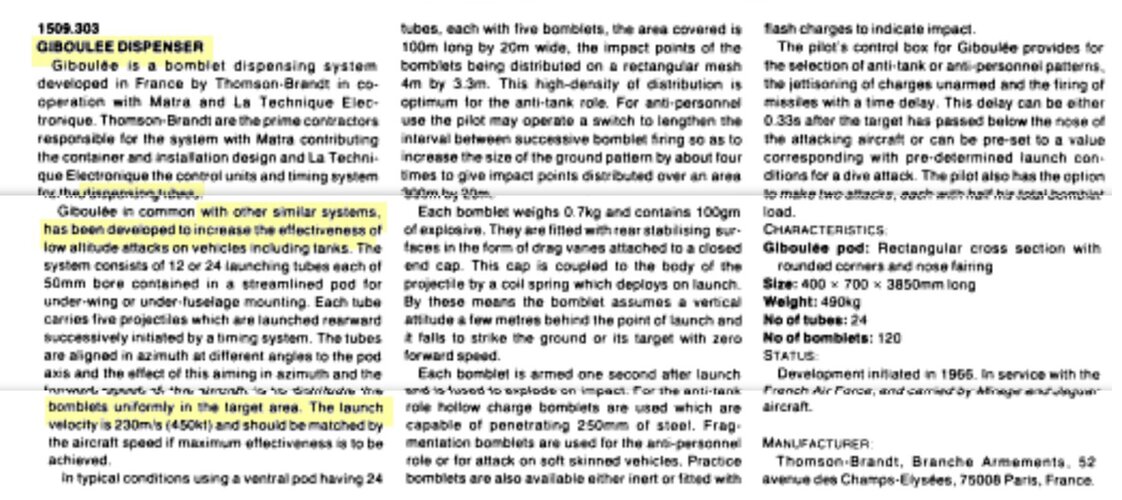GIBOULEE DISPENSER
Giboulée is a bomblet dispensing system developed in France by Thomson-Brandt in cooperation with Matra and La Technique Electronique. Thomson Brandt are the prime contractors responsible for the system with Matra contributing the container and installation design and La Technique Electronique the control units and timing system for the dispensing tubes.
Giboulée in common with other similar systems, has been developed to increase the effectiveness of low altitude attacks on vehicles including tanks. The system consists of 12 or 24 launching tubes each of 50mm bore contained in a streamlined pod for under-wing or under-fuselage mounting. Each tube carries five projectiles which are launched rearward successively initiated by a timing system. The tubes are aligned in azimuth at different angles to the pod axis and the effect of this aiming in azimuth and the forward speed of the aircraft is to distribute the bomblets uniformly in the target area. The launch velocity is 230m/s (450kt) and should be matched by the aircraft speed if maximum effectiveness is to be achieved.
In typical conditions using a ventral pod having 24 tubes, each with five bomblets, the area covered is 100m long by 20m wide, the impact points of the bomblets being distributed on a rectangular mesh 4m by 3.3m. This high-density of distribution is optimum for the anti-tank role. For anti-personnel use the pilot may operate a switch to lengthen the interval between successive bomblet firing so as to increase the size of the ground pattern by about four times to give impact points distributed over an area 300m by 20m.
Each bomblet weighs 0.7kg and contains 100gm of explosive. They are fitted with rear stabilising surfaces in the form of drag vanes attached to a closed end cap. This cap is coupled to the body of the projectile by a coil spring which deploys on launch. By these means the bomblet assumes a vertical attitude a few metres behind the point of launch and falls to strike the ground or its target with zero forward speed. Each bomblet is armed one second after launch and is fused to explode on impact. For the anti-tank role hollow charge bomblets are used which are capable of penetrating 250mm of steel. Fragmentation bomblets are used for the anti-personnel role or for attack on soft skinned vehicles. Practice bomblets are also available either inert or fitted with flash charges to indicate impact.
The pilot's control box for Giboulée provides for the selection of anti-tank or anti-personnel patterns, the jettisoning of charges unarmed and the firing of missiles with a time delay. This delay can be either 0.33s after the target has passed below the nose of the attacking aircraft or can be pre-set to a value corresponding with pre-determined launch conditions for a dive attack. The pilot also has the option to make two attacks, each with half his total bomblet load.
CHARACTERISTICS
Giboulee pod: Rectangular cross section with rounded corners and nose fairing
Size: 400×700× 3850mm long
Weight: 490kg
No of tubes: 24
No of bomblets: 120
STATUS:
Development initiated in 1965. In service with the French Air Force, and carried by Mirage and Jaguar aircraft.

